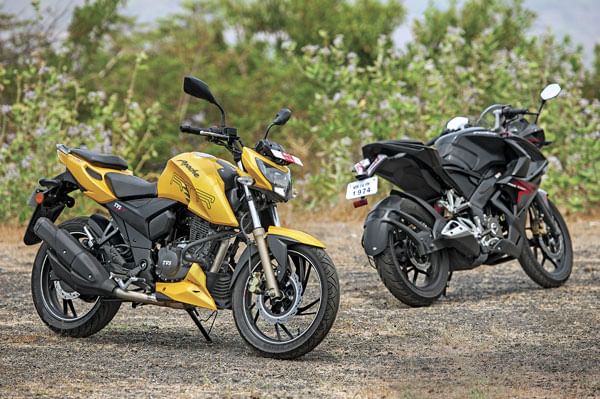The two 200s in this test strive to achieve similar ends, but are quite different in the way they go about doing that. The TVS Apache RTR 200 and Bajaj Pulsar RS 200 sit at the very creamy edge of the entry-level sports bike range, where sportiness and everyday practicality do still go hand-in-hand. Past this point, segment focus leans noticeably towards performance and dynamics, while everyday needs shift closer to the pillion seat.
Bajaj’s Pulsar 200 NS has been out of showrooms for some time, which has given the more recent AS family some breathing space. So, the fuel-injected RTR 200 must inevitably square-off against the Pulsar RS 200, despite both approaching their intended riders with different pitches. The RTR boasts track-bred TVS genes, while the RS is proud of its Bajaj street focus, which isn’t to say these bikes can’t hold their own around a race track.
Picking one winner calls upon plenty of head scratching and close scrutiny.
Fair-ing play
Stood next to each other, it is immediately apparent that these two motorcycles have different upbringings. The Pulsar glowers, and carries a chip on its shoulder, perhaps in some measure due to its deep-set projector lamps that stare balefully out of a heavily sculpted fairing, which is missing on the Apache. The RS 200’s panels look overdone, with different layers and graphics and then there’s that tail-lamp, which is, well, quite unconventional to say the least. There’s no denying that the RS 200 can turn heads, but you should know not all the glances will be admiring. As expected, the Pulsar features a fair bit of Bajaj trademark kit like back-lit switches and a blue back-lit instrument console. One grouse though, could be its lack of a gear position indicator.

The RTR 200 isn’t any pushover either. The cut of its headlamp and the DRLs that flank the always-on pilot-lamp grab attention. There’s a swarthy feel granted by the TVS bike’s massive tank, exaggerated by extensions that jut out of both sides. But, neat touches like a beautiful matte- yellow paint finish, an offset fuel filler cap, smartly buffed levers and a chunky gear-like bezel for the combi-lock, all reek of class. The white back-lit instrument cluster is easy on the eye just as on the RS 200, and feature-packed. It has modes to record acceleration times, maximum top speed and even your lap times.
Both the RTR 200 and RS 200 come with good overall quality, fit-and-finish as well as top-drawer attention-to-detail.
















































